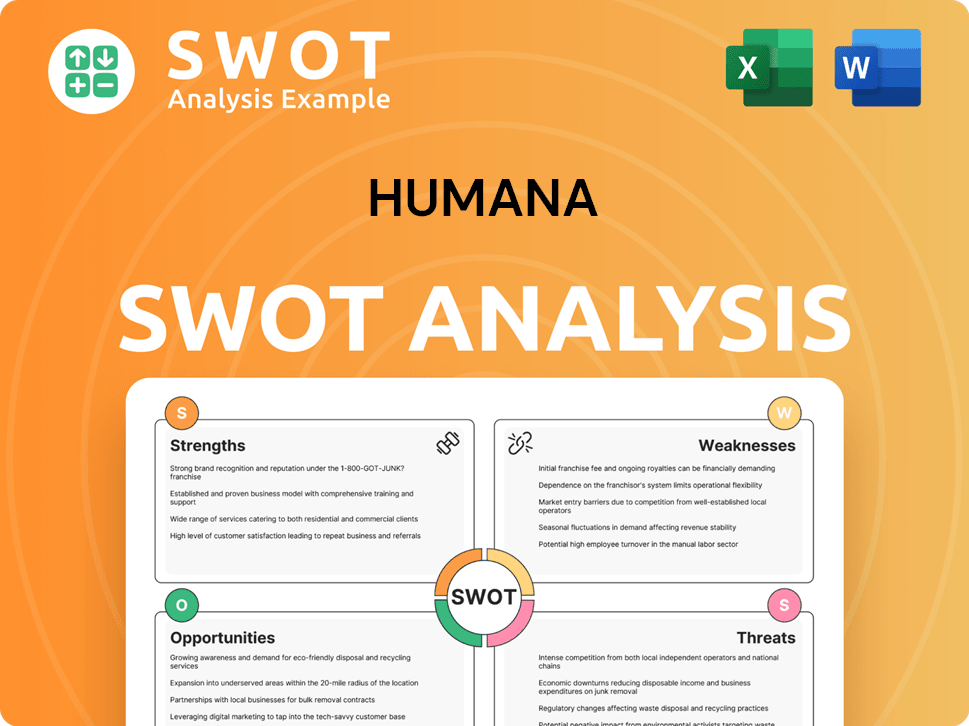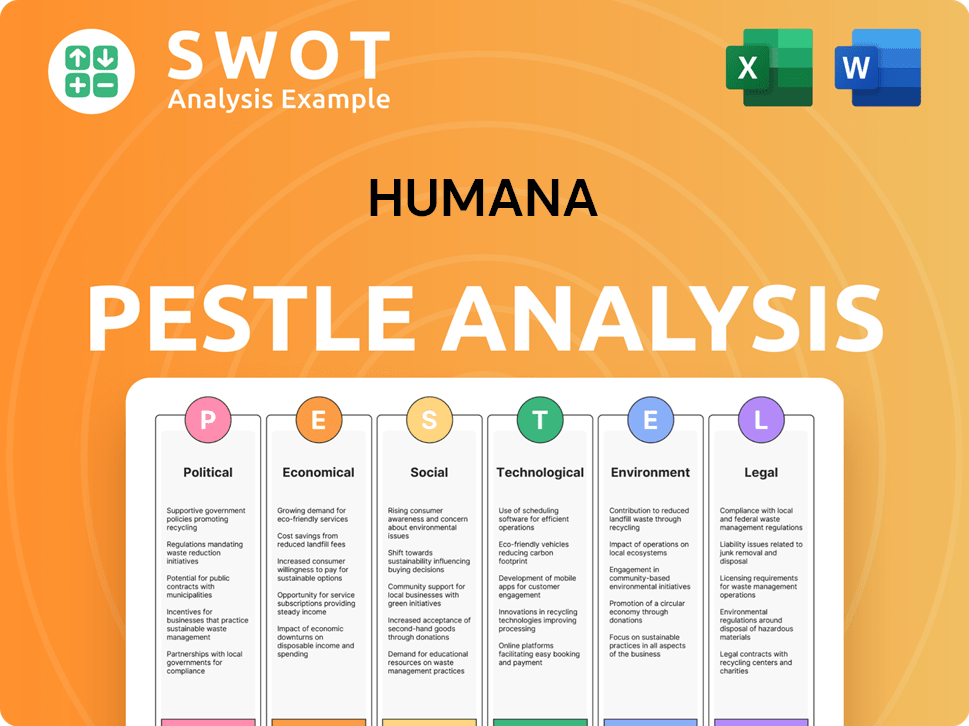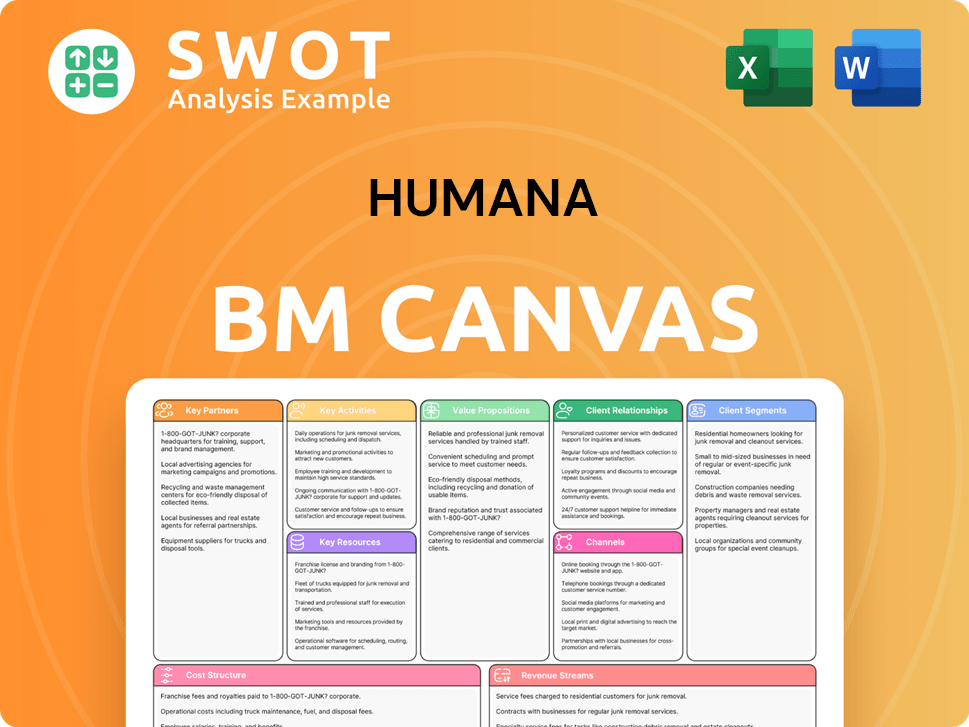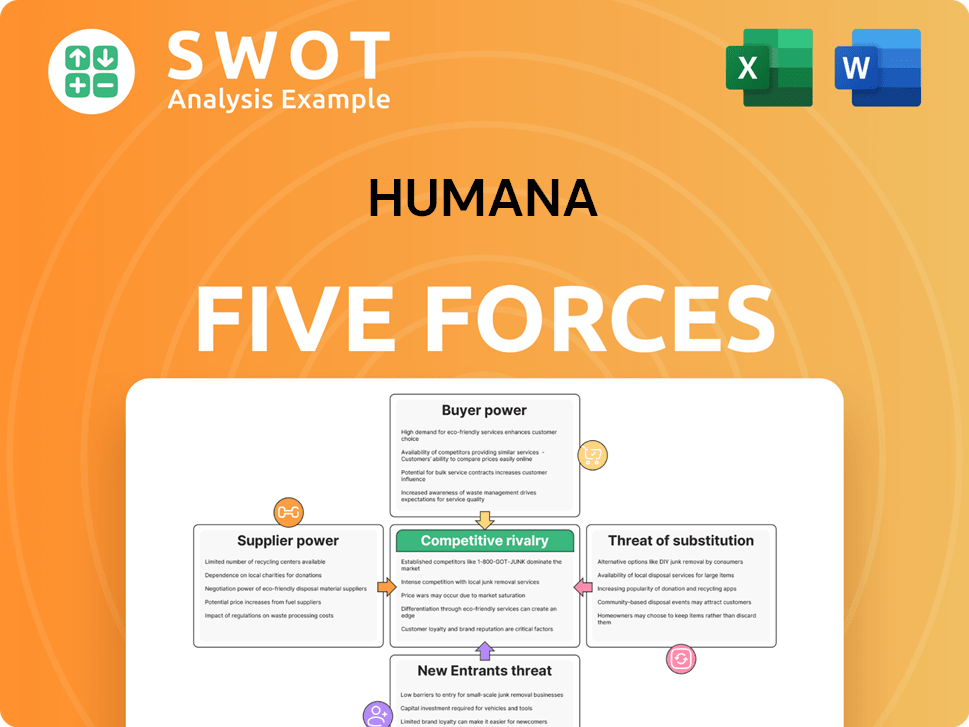Humana Bundle
How Does Humana Stack Up in Today's Healthcare Arena?
Humana Inc. has carved a significant niche in the complex healthcare industry. With a history rooted in nursing homes, the company has transformed into a leading health and well-being enterprise. This evolution highlights Humana's adaptability and strategic foresight in a sector marked by constant change.

To truly understand Humana's position, a detailed Humana SWOT Analysis is essential. This analysis explores the Humana competitive landscape, examining its key rivals and competitive advantage within the health insurance companies sector. We'll delve into Humana's market analysis, assessing its strengths, weaknesses, and strategies for sustained growth in the face of intense competition within the healthcare industry.
Where Does Humana’ Stand in the Current Market?
Humana holds a significant position within the U.S. healthcare industry, particularly in the Medicare Advantage sector. As of early 2024, the company is the second-largest provider of Medicare Advantage plans by enrollment. Its core operations revolve around providing a comprehensive suite of health and well-being services, including medical, dental, vision, and supplemental benefit plans, with a strong emphasis on coordinated care.
The company's value proposition centers on improving health outcomes through integrated health services and a focus on value-based care models. Humana's business model includes a strong presence in pharmacy services through its Humana Pharmacy and CenterWell Pharmacy brands, as well as home-based services and clinical care via its CenterWell brand. This integrated approach aims to provide a more holistic approach to healthcare delivery, catering to diverse customer segments, including employer groups, government-sponsored programs, and individuals.
Humana's strategic shift towards value-based care and integrated health services demonstrates its commitment to adapting to industry trends. The company's financial performance reflects its operational scale, with revenues of $106.4 billion for the full year 2023. While facing profitability challenges, including a net loss of $541 million in Q4 2023, its strong revenue base and strategic focus on key growth areas, such as Medicare Advantage, underscore its significant market footprint. For a deeper understanding, explore Revenue Streams & Business Model of Humana.
Humana is a major player in the Medicare Advantage market. The company's market share is substantial, with approximately 5.2 million Medicare Advantage members as of December 31, 2023. This significant enrollment highlights its competitive position within the healthcare industry.
Humana has a broad national presence across the United States. Its customer base includes employer groups, government-sponsored programs, and individual members. This diverse customer base supports its market position and growth strategies in the healthcare market.
Humana's financial performance reflects its operational scale. The company reported revenues of $106.4 billion for the full year 2023. Despite a net loss of $541 million in Q4 2023, its revenue base indicates a strong market footprint.
Humana strategically emphasizes value-based care and integrated health services. Investments in CenterWell aim to provide a more holistic approach to healthcare. This focus is a key part of Humana's competitive advantage.
Humana's strengths include its strong market position in Medicare Advantage and its integrated health services model. The company's weaknesses involve profitability challenges due to higher medical costs. Understanding these aspects is crucial for a Humana market analysis.
- Strengths: Strong presence in Medicare Advantage, integrated health services, and a focus on value-based care.
- Weaknesses: Profitability pressures, particularly in Q4 2023, due to higher medical costs.
- Opportunities: Growth in the Medicare Advantage market, expansion of CenterWell services, and strategic partnerships.
- Threats: Regulatory changes, increased competition from other health insurance companies, and fluctuations in healthcare costs.
Humana SWOT Analysis
- Complete SWOT Breakdown
- Fully Customizable
- Editable in Excel & Word
- Professional Formatting
- Investor-Ready Format

Who Are the Main Competitors Challenging Humana?
The Humana competitive landscape is characterized by intense rivalry within the healthcare industry. Understanding Humana's competitors is crucial for assessing its market position and strategic direction. This analysis provides insights into the key players challenging Humana and their respective strengths.
Humana's market analysis reveals a dynamic environment shaped by both direct and indirect competitors. These entities vie for market share across various segments, including Medicare Advantage, employer-sponsored plans, and government programs. The competitive strategies employed by these players influence Humana's ability to maintain and grow its business.
UnitedHealthcare, a division of UnitedHealth Group, is a major competitor. It offers a wide array of health benefit products and services. Its substantial market share and comprehensive offerings pose a significant challenge.
Elevance Health is another key competitor, especially strong in the Blue Cross Blue Shield plans. It competes across various segments, leveraging strong brand recognition and provider networks.
CVS Health, through its Aetna health insurance arm, is a key competitor. The integration with CVS Health's pharmacy and retail clinics provides a unique competitive advantage.
Centene Corporation focuses heavily on government-sponsored healthcare programs. Its expertise in managing complex care populations and its presence in underserved markets present a unique competitive dynamic.
Humana also faces competition from regional health plans and emerging players. These entities focus on specific niches like digital health or value-based care models.
Mergers and alliances, such as the CVS-Aetna merger, create more integrated healthcare entities. These developments intensify the pressure on companies like Humana to innovate and differentiate.
These health insurance companies use various strategies to compete, including aggressive pricing, innovative product development, and strong branding. For a deeper understanding of how Humana approaches its market, consider reading about the Marketing Strategy of Humana. A critical aspect of Humana's competitive strategy involves leveraging technology and partnerships to enhance its offerings and maintain a competitive advantage. The healthcare industry is constantly evolving, and Humana's strengths and weaknesses analysis must consider these shifts.
Several factors drive competition in the healthcare market. These include pricing strategies, network size, and the integration of healthcare services.
- Pricing: Competitive pricing is essential for attracting and retaining customers.
- Network Size: A broad and accessible provider network enhances customer satisfaction.
- Service Integration: Integrated services, such as pharmacy benefits and telehealth, provide a competitive edge.
- Technology: Investments in digital health and data analytics improve efficiency and customer experience.
- Brand Reputation: A strong brand builds trust and loyalty among consumers.
Humana PESTLE Analysis
- Covers All 6 PESTLE Categories
- No Research Needed – Save Hours of Work
- Built by Experts, Trusted by Consultants
- Instant Download, Ready to Use
- 100% Editable, Fully Customizable

What Gives Humana a Competitive Edge Over Its Rivals?
To understand the Humana competitive landscape, it's crucial to examine its core strengths. The company has strategically positioned itself within the healthcare industry, particularly excelling in the Medicare Advantage segment. This focus allows for operational efficiencies and competitive pricing, impacting its Humana market analysis.
Humana's integrated care model, especially through its CenterWell brand, offers a comprehensive healthcare experience. This approach, encompassing primary care, pharmacy services, and home health, enhances customer loyalty and helps manage costs. This integration is a key aspect when considering Humana's competitive advantage.
The company's commitment to innovation and technology further strengthens its position. By leveraging data analytics and technology, Humana personalizes member experiences and optimizes care delivery. This focus on technological advancements supports value-based care initiatives and improves risk management, which is essential when assessing Humana's competitors.
Humana is a leading provider in the Medicare Advantage market, benefiting from significant economies of scale. As of 2024, Humana has a substantial market share in this segment, which is a key driver of its financial performance. This strong position allows the company to negotiate favorable terms with healthcare providers and offer competitive pricing.
The CenterWell brand provides a holistic healthcare experience, including primary care, pharmacy, and home health services. This integrated approach improves health outcomes and manages chronic conditions more effectively. This model enhances customer loyalty and reduces overall healthcare costs, setting Humana apart from some of its Humana competitors.
Humana leverages data analytics to personalize member experiences, optimize care delivery, and improve operational efficiencies. These technological investments support value-based care initiatives and better risk management. This focus on technology is crucial for maintaining a competitive edge in the healthcare industry.
Humana's established brand equity fosters customer trust and retention. The company's focus on member satisfaction and supplemental benefits attracts and retains members. This brand strength is a significant advantage in the competitive health insurance companies market.
Humana's competitive advantages are multifaceted, including its strong market position, integrated care model, and technological prowess. These strengths help the company navigate the complex Humana competitive landscape effectively. For more insights into Humana's financial performance, check out Owners & Shareholders of Humana.
- Market Leadership: Dominance in the Medicare Advantage segment allows for economies of scale and competitive pricing.
- Integrated Care: CenterWell's holistic approach improves health outcomes and enhances customer loyalty.
- Technological Integration: Data analytics and technology personalize member experiences and optimize care delivery.
- Brand Strength: Strong brand equity fosters customer trust and supports member retention.
Humana Business Model Canvas
- Complete 9-Block Business Model Canvas
- Effortlessly Communicate Your Business Strategy
- Investor-Ready BMC Format
- 100% Editable and Customizable
- Clear and Structured Layout

What Industry Trends Are Reshaping Humana’s Competitive Landscape?
The Growth Strategy of Humana is significantly shaped by the dynamic shifts within the healthcare industry. Understanding the Humana competitive landscape requires a close examination of industry trends, future challenges, and emerging opportunities. The company's position is influenced by technological advancements, regulatory changes, and evolving consumer preferences, all of which affect its strategic direction and market performance.
The healthcare sector faces constant change, with companies like Humana navigating complex issues. The competitive environment is shaped by factors such as rising medical costs, intense competition, and the need for greater transparency. Despite these challenges, Humana has opportunities for growth, particularly in the expanding Medicare Advantage market and through strategic initiatives like CenterWell.
Technological advancements, including data analytics, AI, and telehealth, are transforming healthcare delivery and member engagement. Regulatory changes, especially regarding Medicare Advantage and drug pricing, continue to influence the competitive landscape. Consumer preferences are shifting towards more convenient, personalized, and value-based care models, increasing demand for services like telehealth and home-based care.
Managing escalating medical costs, particularly within Medicare Advantage plans, poses a significant challenge. Intense competition from larger, diversified healthcare companies and new market entrants threatens market share and pricing power. The increasing demand for transparency and accountability in healthcare requires companies to demonstrate clear value and improved outcomes.
The aging U.S. population continues to drive demand for Medicare Advantage plans, a segment where Humana holds a strong position. Expanding integrated care offerings through CenterWell and exploring new partnerships in health technologies present avenues for growth. Innovations in chronic disease management and preventative care offer opportunities to improve member health and reduce costs.
Humana is likely to evolve towards a more integrated and technology-driven model, emphasizing value-based care and personalized member experiences. The company is deploying strategies focused on optimizing its Medicare Advantage business, expanding its healthcare services capabilities, and managing costs. These efforts aim to capitalize on future opportunities and maintain a competitive edge.
Humana's Humana market analysis reveals the need to adapt to industry changes and capitalize on growth prospects. The company must address rising medical costs and intense competition while leveraging its strengths in Medicare Advantage and integrated care.
- Competitive Advantage: Humana's focus on value-based care and integrated services positions it well.
- Market Share: Maintaining and growing market share in the face of competition is crucial.
- Financial Performance: Managing costs and improving operational efficiency are key to profitability.
- Strategic Partnerships: Collaborations and technology investments will drive innovation and growth.
Humana Porter's Five Forces Analysis
- Covers All 5 Competitive Forces in Detail
- Structured for Consultants, Students, and Founders
- 100% Editable in Microsoft Word & Excel
- Instant Digital Download – Use Immediately
- Compatible with Mac & PC – Fully Unlocked

Related Blogs
- What are Mission Vision & Core Values of Humana Company?
- What is Growth Strategy and Future Prospects of Humana Company?
- How Does Humana Company Work?
- What is Sales and Marketing Strategy of Humana Company?
- What is Brief History of Humana Company?
- Who Owns Humana Company?
- What is Customer Demographics and Target Market of Humana Company?
Disclaimer
All information, articles, and product details provided on this website are for general informational and educational purposes only. We do not claim any ownership over, nor do we intend to infringe upon, any trademarks, copyrights, logos, brand names, or other intellectual property mentioned or depicted on this site. Such intellectual property remains the property of its respective owners, and any references here are made solely for identification or informational purposes, without implying any affiliation, endorsement, or partnership.
We make no representations or warranties, express or implied, regarding the accuracy, completeness, or suitability of any content or products presented. Nothing on this website should be construed as legal, tax, investment, financial, medical, or other professional advice. In addition, no part of this site—including articles or product references—constitutes a solicitation, recommendation, endorsement, advertisement, or offer to buy or sell any securities, franchises, or other financial instruments, particularly in jurisdictions where such activity would be unlawful.
All content is of a general nature and may not address the specific circumstances of any individual or entity. It is not a substitute for professional advice or services. Any actions you take based on the information provided here are strictly at your own risk. You accept full responsibility for any decisions or outcomes arising from your use of this website and agree to release us from any liability in connection with your use of, or reliance upon, the content or products found herein.